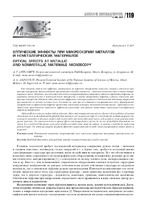| dc.contributor.author | Анисович, А. Г. | ru |
| dc.coverage.spatial | Минск | ru |
| dc.date.accessioned | 2018-01-06T20:11:30Z | |
| dc.date.available | 2018-01-06T20:11:30Z | |
| dc.date.issued | 2017 | |
| dc.identifier.citation | Анисович, А. Г. Оптические эффекты при микроскопии металлов и неметаллических материалов = Optical effects at metallic and nonmetallic materials microscopy / А. Г. Анисович // Литье и металлургия. - 2017. – № 4 (89). - С. 119-125. | ru |
| dc.identifier.uri | https://rep.bntu.by/handle/data/36255 | |
| dc.description.abstract | Рассмотрены оптические эффекты, возникающие на дефектах поверхности металлов, сплавов и оптически прозрачных материалов, при исследовании при различных способах освещения – светлого и темного поля, а также поляризованного света. Показано, что методы оптического контрастирования позволяют надежно определять дефекты поверхности металлических и неметаллических материалов, а также обнаружить дефекты в объеме оптически прозрачных материалов. Показана связь оптических эффектов с конструктивными особенностями объектива микроскопа при освещении по методу темного поля. Установлено, что при исследовании в поляризованном свете формирование изображения на сферическом дефекте происходит аналогично таковому для одноосного кристалла. Предложено схематическое представление оптических эффектов в различных материалах, позволяющее визуальную классификацию дефектов поверхности. | ru |
| dc.language.iso | ru | ru |
| dc.publisher | БНТУ | ru |
| dc.subject | Темнопольное освещение | ru |
| dc.subject | Поляризованный свет | ru |
| dc.subject | Оптически прозрачный материал | ru |
| dc.subject | Металлический материал | ru |
| dc.subject | Dark-field illumination | en |
| dc.subject | Polarized light | en |
| dc.subject | Optically transparent material | en |
| dc.subject | Metallic material | en |
| dc.title | Оптические эффекты при микроскопии металлов и неметаллических материалов | ru |
| dc.title.alternative | Optical effects at metallic and nonmetallic materials microscopy | en |
| dc.type | Article | ru |
| dc.relation.journal | Литье и металлургия | ru |
| local.description.annotation | Optical effects arising on surface defects of metals, alloys and transparent materials are discovered in conditions of various illumination such as dark-field and bright-field illumination as well as polarized light. It is shown that the methods of optical contrasting let it possible to determine surface defects of metallic and nonmetallic materials as well as defects inside optically transparent materials. The connection between optical effects and design features of lens by the use of dark-field illumination was shown. It is established that picture generation of spherical defect came about by analogy to uniaxial crystal by the study using polarized light. The schematic diagram of optical effects for various materials to make visual classification of surface defects is suggested. | en |

